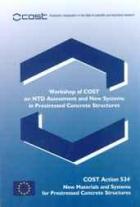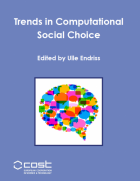
Arbuscularmycorrhizas in Sustainable Soil-plant Systems - Activity Report 1996

Actions COST - Recueil des Accords Vol2 1981-1982

Project COST 3010 - 03/1984-10/1985

Workshop of COST on NTD Assessment and New Systems in Prestressed Concrete Structures
- Pages: 252
- Author(s): M. C. Alonso, J. Tritthart, J. Gulikers et al
- ISBN/ISSN: 978-83-7204-447-1 | 83-7204-447-3
COST Action 534 – New Materials and Systems for Prestressed Concrete Structures, abstracts of the workshop on NTD Assessment and New Systems in Prestressed Concrete Structures.

Basic & Clinical - Pharmacology & Toxicology (Volume 96, N° 3, March 2005) - Action COST B15: "Modelling During Drug Development"
- Pages: 271 pages
- Author(s): K. Brosen
- Publisher(s): Nordic Pharmacological Society
- ISBN/ISSN: ISSN : 1742-7835 | 1742-7835
The main objective of the Action was to improve the predictive potential of scientific information gathered within the framework of development of new, efficacious and safe drugs, as well as sustainable industrial chemicals. Some form of modelling is performed during any of these “steps” have some contact with others, active in “neighbours steps”. However, as often demonstrated in practice, valuable information is not necessarily available for scientists active in “steps” that are further apart. For industrial chemicals, “empirically fixed safety factors” are presently used to scale up from animal data to humans.
This approach is not scientifically well based and does not take into consideration all information which is (or could be made) available. In this context, Action COST B15 provided a powerful tool to improve communication between scientists from Academia, the Industry and Governmental Entities.

European Rural Development Policy 2007-2013: A Planning Framework
- Pages: 99
- Author(s): E. Calderón
- ISBN/ISSN: 978-84-7493-403-8
The present final report describes the result of a 2-year collaborative research effort undertaken within the scope of COST Action C27, through its working Group 1.

Trends in Computational Social Choice
- Author(s): Ulle Endriss
- Publisher(s): AI Access
- http://research.illc.uva.nl/COST-IC1205/BookDocs/TrendsCOMSOC.pdf
This volume has been produced by COST Action IC1205 on Computational Social Choice, a European research network set up to advance the state of the art in computational social choice by supporting the international research community in this domain.

Dating, synthesis, and interpretation of palaeoclimatic records and model-data integration: advances of the intimate project (integration of ice core, marine and terrestrial records, COST Action ES0907)
- Pages: 330
- Author(s): Sune Olander Rasmussen, Achim Brauer, Ana Moreno and Didier Roche
- Publisher(s): Elsevier
- Download from external website
- ISBN/ISSN: |
Since 2010, the INTIMATE (INTegration of Ice-core, MArine and TErrestrial records) network has been operating as a COST Action (designated ES0907). This paper outlines the accomplishments of the INTIMATE COST Action in the context of how the INTIMATE ideas have evolved during the network’s twenty-year life span, and highlights a number of challenges that can guide further work. In the second part of the paper, the contributions that compromise this INTIMATE special issue are introduced.

The Good, the Bad, the Unexpected: Conference Proceedings Volume II
- Pages: 595
- Author(s): B. Sapio, L. Fortunati, L. Haddon, K. Kommonen, E. Mante-Maijer and T. Turk
- Publisher(s): OPOCE
- Download from external website
- ISBN/ISSN: 978-92-898-0042-6
- EUR: 23328
The main objective of the conference was to create new knowledge about users’ creativity and facilitate their empowerment in a broadband information society. This knowledge is crucial in order to strengthen the European Research Area. Moreover, this requieres an examination of the factors that can both constrain and enhance users’ abilities to shape and use ICTs. In this conference, the organisers invited technology and product developers, designers, social scientists, policy makers, community representatives and others who are interested in the conference topics, to join the attempt to develop this discussion on a common, shared and transdisciplinary ground.
